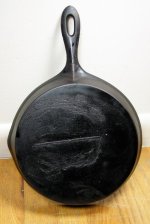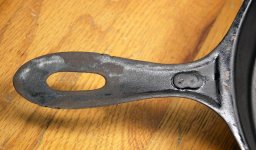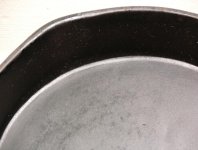Hi all,
This is my first post here. I am an "accidental" cast iron collector like most antiques that my wife and I have- they usually find me not the other way around.
Here's the start of my cast iron collection story.
In a visit to a good friend's house a few months ago he gave me a bunch of items for the local scrapyard as I visit there frequently. In the load of broken stuff were a dozen or so intact, heavy, well used cast iron pans of various size and shape. These I saved as I thought I could use for melting wax or mixing paints etc. That never happened thankfully.
My wife and I are very into cooking (foodies) and have gotten away from using non stick as the teflon and aluminum products contained within these seem like they are not safe anymore to ingest.
So I looked into Cast Cookware...With a little research and some effort I have managed to restore quite a collection of very nice cookware. A Lodge grill pan, three or four #3, #5, #8 Wagner Ware, a 1930's 10" Griswold and one I think may be a Sperry 8. It has a flat handle on top as well as the cast seam on the bottom. I'll post pics and maybe someone can help me identify?
I noticed not too many posts here focused on abrasive blasting. Oven cleaners and lye just seem like too caustic a process to me for an item later eaten off of(just my 2 cents)
I am a metalworker by trade and have use an abrasive blasting cabinet for my business and have for almost a decade now. This cabinet is a suction style machine (gentler that a pressure cabinet) which I can gently coax off rust and gunk from my pans using a very fine aluminum oxide grit and low pressure. It filters material so the abrasive is separated cyclonically from the gunk and dirt that it removes. Recycling a clean abrasive every few minutes.
The abrasive is a #70-80 grit Aluminum Oxide which easily powers through rust and crud leaving a very smooth and clean surface.
I have achieved great results! Abrasive blasting works great- as does a re-seasoning on my BBQ grill at 300-375 degrees with Crisco for an hour.
These super smooth vintage cast iron pans are easily made non-stick and cook great! My favorite Dutch Babies for breakfast are beautiful! YUM!
Should anyone need abrasive blast advice or assistance I'd gladly do my best to steer you in the right direction. Also would appreciate any comments regarding abrasive blasting or suggestions as well...
Thanks for the great group,
Greg:razz:
This is my first post here. I am an "accidental" cast iron collector like most antiques that my wife and I have- they usually find me not the other way around.
Here's the start of my cast iron collection story.
In a visit to a good friend's house a few months ago he gave me a bunch of items for the local scrapyard as I visit there frequently. In the load of broken stuff were a dozen or so intact, heavy, well used cast iron pans of various size and shape. These I saved as I thought I could use for melting wax or mixing paints etc. That never happened thankfully.
My wife and I are very into cooking (foodies) and have gotten away from using non stick as the teflon and aluminum products contained within these seem like they are not safe anymore to ingest.
So I looked into Cast Cookware...With a little research and some effort I have managed to restore quite a collection of very nice cookware. A Lodge grill pan, three or four #3, #5, #8 Wagner Ware, a 1930's 10" Griswold and one I think may be a Sperry 8. It has a flat handle on top as well as the cast seam on the bottom. I'll post pics and maybe someone can help me identify?
I noticed not too many posts here focused on abrasive blasting. Oven cleaners and lye just seem like too caustic a process to me for an item later eaten off of(just my 2 cents)
I am a metalworker by trade and have use an abrasive blasting cabinet for my business and have for almost a decade now. This cabinet is a suction style machine (gentler that a pressure cabinet) which I can gently coax off rust and gunk from my pans using a very fine aluminum oxide grit and low pressure. It filters material so the abrasive is separated cyclonically from the gunk and dirt that it removes. Recycling a clean abrasive every few minutes.
The abrasive is a #70-80 grit Aluminum Oxide which easily powers through rust and crud leaving a very smooth and clean surface.
I have achieved great results! Abrasive blasting works great- as does a re-seasoning on my BBQ grill at 300-375 degrees with Crisco for an hour.
These super smooth vintage cast iron pans are easily made non-stick and cook great! My favorite Dutch Babies for breakfast are beautiful! YUM!
Should anyone need abrasive blast advice or assistance I'd gladly do my best to steer you in the right direction. Also would appreciate any comments regarding abrasive blasting or suggestions as well...
Thanks for the great group,
Greg:razz:



